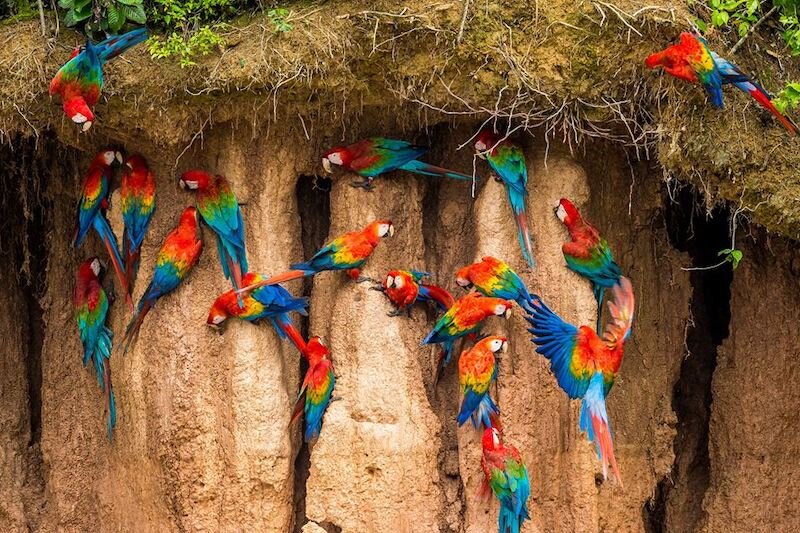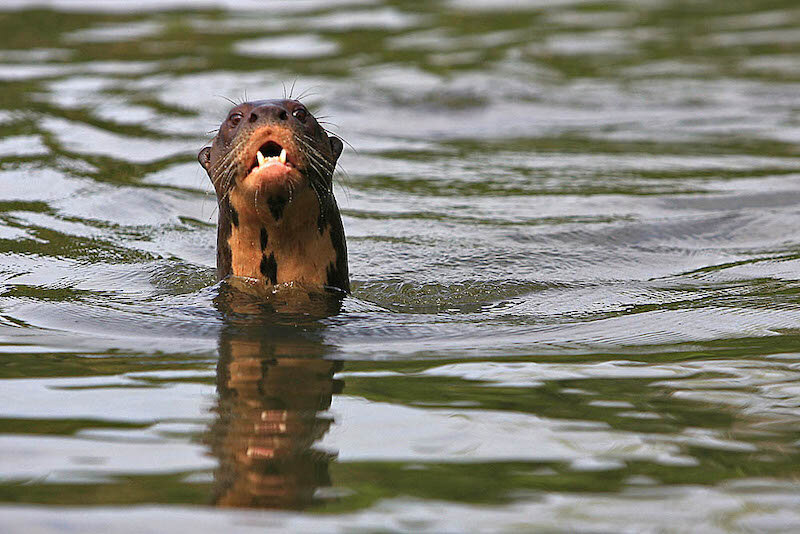A Guide to Tambopata National Reserve
Tambopata National Reserve was created in September 2000 to protect a huge swathe of lowland rainforest along the south bank of the Tambopata River.
The reserve overlaps the Departments of Madre De Dios and Puno, covering an area of 274,690 hectares (1,061 square miles) from Puerto Maldonado to the Bolivian border to the east, and Bahuaja-Sonene National Park to the south.
Motorboat on Tambopata River.
The elevation ranges from 260 m (853 ft) to forested hills reaching 600 m (1,968 ft) in height. But undoubtedly, the region is dominated by the flood plains of its numerous meandering rivers, such as the Tambopata, Malinowski, Heath, which all eventually flow into the Madre de Dios River.
The most striking feature of this landscape are the isolated former river channels, the ox-bow lakes, which are replete with wildlife.
Flora & Fauna in Tambopata National Reserve:
In this lowland region, the jungle is technically known as Subtropical Moist Forest. Put simply, this means that the climate is ‘warm and humid’ rather than ‘hot and wet’.
Pair of jaguars on banks of Tambopata River.
Like all of Peru’s Amazon reserves, the area is known for its incredible biodiversity: over 1,700 flora species; more than 600 bird species; 200 fish species; 160 different types of reptiles and amphibians; and an astounding 1,217 varieties of butterfly.
Moreover, Tambopata is known for its prevalence of large jungle animals:
Black Caiman (Melanosuchus niger)
Giant Otter (Pteronura brasiliensis)
Jaguar (Felis onca)
Puma (Felis concolor)
Ocelot (Felis pardalis)
Jaguarundi (Herpailurus yagouaroundi)
Tapir (Tapirus terrestris): tracks can be seen on trails and riverbanks.
Collared Peccary (Perari tajacu)
White-lipped Peccary (Tayassu perari)
Capybara (Hydrochoerus hydrochaeris)
Hoffmann's Two-toed Sloth (Choloepus hoffmanni)
A wealth of monkey species, including:
Red Howler Monkey (Alouatta sara)
Black-Faced Spider Monkey (Ateles chanek)
Saddle-back Tamarin (Saguinus weddelli)
Black-capped Squirrel Monkey (Saimiri boliviensis)
Toppin’s Titi Monkey (Callicebus toppini)
Night Monkey (Aotus cf. nigriceps)
Large-Headed Capuchin (Sapajus macrocephalus)
Shock-Headed Capuchin (Cebus cuscinus)
Chuncho Clay Lick on Tambopata River.
The diversity of habitats provides good birding opportunities, especially at the world-renowned kolpas: clay licks which attract at least three species of macaw - Blue & Yellow, Scarlet, and Red & Green - along with parrots and parakeets, to extract minerals from the exposed river bank, at dawn or dusk.
On a busy morning, the effect is a riot of avian colour and noise, that is undoubtedly one of the absolute highlights of an Amazon jungle visit.
Of the roughly 600 or so other bird species to be found in Tambopata, here are some of the more striking:
Rufescent Tiger Heron (Tigrisoma lineatum)
King Vulture (Sarcoramphus papa)
Roseate Spoonbill (Platalea ajaja)
Razor-billed Curassow (Mitu tuberosum)
Horned Curassow (Pauxi unicornis)
Variegated Tinamou (Crypturellus variegatus)
Sunbittern (Eurypyga helias)
Golden-tailed Sapphire (Chrysuronia oenone): a member of the hummingbird family
White-necked Jacobin (Florisuga mellivora): another hummingbird
Crested Eagle (Morphnus guianensis)
Giant Harpy Eagle (Arpyia harpja): the worlds most powerful bird of prey.
Anthropology of Tambopata Natural Reserve:
There are small populations of the indigenous Ese Ejja and Pukirieri inhabiting the buffer zone surrounding Tambopata Reserve.
Ese Ejja bow & arrow demonstration in Infierno.
In 1974, members of the Ese Ejja formed the first officially-recognised Native Community in Madre de Dios at Infierno, with the legal grant of 9,558 hectares (37 square miles) of land on either side of the Tambopata River.
This community co-owns the excellent Posada Amazonas Amazon Lodge. Profits are shared amongst the whole community, who also provide most of the staff.
Many of the excursions reflect the close relationship between the lodge and the Ese Ejja, with storytelling activities, home visits and handicrafts workshops.
How To Visit Tambopata Natural Reserve:
Rivers provide the main travel routes into the Reserve, beginning and ending in Puerto Maldonado.
Tambopata River: Heading upstream from Puerto Maldonado, snow-covered peaks of the Andes come into view.
There are various excellent Amazon lodges located along the banks of the Tambopata, including Wasai and Refugio Amazonas … and the remotest of them all, Tambopata Research Center.
For a an in-depth exploration of the Tambopata River, as it makes its way from the Andes mountains near Lake Titicaca to the Amazon River, we have an epic Tambopata River Rafting itinerary.
Giant River Otter in Lake Sandoval.
Madre de Dios River: Several well-established Amazon lodges are within an hour or two by speedboat, downstream from Puerto Maldonado.
One of the plushest lodges in the whole of the Peruvian Amazon, Reserva Amazonica, is on its banks.
Lake Sandoval, an oxbow lake created by the Madre de Dios River, is famous for its family of Giant River Otters, and has nearby lodge accommodation.






